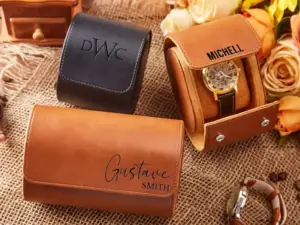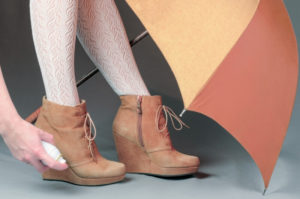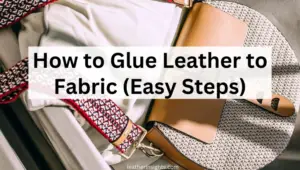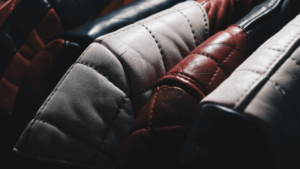How to Seal Leather after Dyeing
Sealing leather is a simple and effective way to preserve and protect your items from damage and everyday wear and tear. However, leather can dry up and deteriorate over time if not properly sealed and maintained.
In this article, we’ll guide you through the steps on how to seal leather properly from selecting the right leather sealant to properly applying it.
So whether you’re a fashion enthusiast looking to extend the life of your leather jacket, or a shoe collector looking to protect your favorite pair of boots, this guide is a must-read.
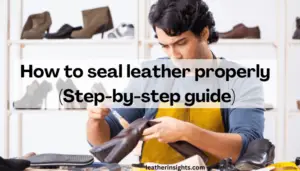
How to seal leather properly
To seal leather, you need to first clean the leather surface to remove dirt and debris and then apply your ideal leather sealant using a soft cloth or brush. Ensure you apply the sealant evenly on the leather item before allowing it to dry.
It is important to point out that you should seal your leather after dyeing and not before. Doing this helps to protect and preserve the color of the leather dye or stain and prevents fading or bleeding.
Additionally, it keeps your leather items from damage that is caused by dirt, water, and other elements and gives them a polished appearance.
Below is a step-by-step guide on how to do this properly.
Step 1: Prepare your leather item
The first step in the sealing process is to prepare your leather item by cleaning and drying it.
If you have just dyed your leather, let dry completely first and then dust it off to remove any dirt and debris from the surface of the leather.
You will need to use a soft dry cloth to avoid getting the leather wet or damp which can rub off the dye.
Step 2: Choose a leather sealant
Once your leather item is clean, dry, and in good condition, it’s time to pick your leather sealant. In fact, this should be the first step before you embark on the sealing process.
When choosing a leather sealant, make sure it is specifically designed to be used on leather and not wood or fabric and it should be user-friendly.
Also, choose a sealant that is durable and flexible enough so that it doesn’t crack or peel over time since leather itself is flexible.
Most importantly, if you have just dyed your leather, make sure the sealant you pick will not affect the color or finish.
A clear sealant such as this Top Coat Satin Finish Sealer is always a good option. It dries fast leaving a beautiful satin sheen finish on the leather that is water-resistant.
Step 3: Apply the sealant
The leather sealant comes ready to use and does not need to be mixed or diluted with anything.
But before you start, test the sealant in an inconspicuous area of the leather first to make sure it doesn’t cause staining, discoloration, or any damage. Remember to wear gloves to protect yourself from the sealant and ensure you are in a well-ventilated area.
If it works fine, start the application process using a soft cloth or brush to apply the sealant evenly on the surface of the leather.
Pay extra attention to the instructions provided by the manufacturer so as to get the best results. If the sealant requires multiple coats, make sure to allow the first coat to dry completely before applying the next one.
Step 4: Leave the sealant to dry
Leave the sealant to dry completely after applying the first coat. This takes different times depending on the product, the humidity, and the temperature conditions in your area.
Once dry, check for any missed spots or uneven coverage, especially around crevices and seams.
Step 5: Add another coat if necessary
In case you missed any spot, add another coat of the sealant and leave it to dry once again.
You can apply even a third coat if desired but it’s important to wait for each coat to dry completely before applying the next.
Step 6: Buff the leather
Once your leather item is completely dry, you can buff it to achieve a smooth and shiny surface.
However, not all sealants require buffing and some manufacturers indicate not to buff applying their sealant. This is why it’s important to follow the manufacturer’s instructions carefully.
Which is the best leather sealer to use after dyeing leather?
When dying leather, it is important to use a sealer that is specifically designed for use on leather that will not affect the color or finish of the dye.
Here are a few sealants that are popular for sealing leather after dying.
-
Fiebing’s Leather sheen sealer
Fiebing’s Leather Sheen is a clear, water-based sealer that is designed to provide a glossy finish and protection for leather.
It is a versatile product that can be used on all types of leather to provide protection against water, stains, and UV rays.
This sealant is often used as a final finish after dyeing to lock in the color and give a glossy shine.
It is easy to apply, dries quickly, and you can repeat the process if desired to achieve a desired level of shine.
-
Leather Finish by Angelus
This Leather Finish by Angelus is a clear acrylic-based finish that can be used over dye to protect the color and prevent staining.
It is known for its ability to provide a high-gloss and shiny finish to leather that helps restore its original appearance.
Also, it provides a water-repellent layer on the leather’s surface helping to shield it from stains and water damage. It is also considered among the best leather edge paints so you can use it to seal the edges of your leather items.
-
Resolene acrylic finish
Resolene Acrylic Finish is also a Fiebing’s product that is designed to be used as a top finish for dyed and polished leather.
Unlike the above sealants, Resolene penetrates deep into the leather fibers providing maximum protection against water, stains, and dirt.
It provides a glossy finish and enhances the color of the dye. Also, it works well on raw or unfinished leather due to its ability to penetrate the surface.
The problem with this sealant is that it is non-permeable so you cannot condition your leather items after sealing. For this reason, some people turn to other Resolene substitutes like Tan Kote.
Conclusion
In conclusion, sealing leather is an important step in the process of caring for and preserving your leather goods.
Whether you’re working with raw leather, dyed leather, or leather that has already been finished, there are a variety of sealers and techniques available to help protect and preserve your leather.
By following the steps outlined in this article on how to seal leather, and being mindful of the unique features and recommendations of the products you choose, you can ensure that your leather goods will look great and last for years to come.
Remember that sealing leather is not just a one-time process; it should be repeated periodically to ensure the leather stays in good condition.
And always, if you have any doubts, don’t hesitate to consult with a professional leather worker who can guide you through the process and help you achieve the best results.

